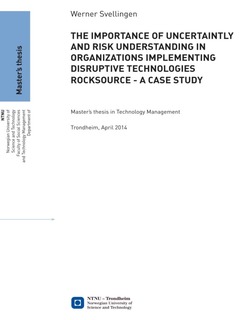| dc.description.abstract | The subject for this thesis focuses on how Rocksource, a Norwegian independent oil and gas company, evaluated prospect uncertainties and risks during the exploration phase, where the main risk is absence of commercially viable hydrocarbons. To mitigate the uncertainty and risk Rocksource implemented the disruptive technology, Controlled Source Electromagnetic Marine (CSEM). For small oil companies the success or failure can be directly related to the ability to understand and manage risks. The ability to understand and quantify uncertainties and risks, and knowing how to manage them effectively, contributes to well-founded business decisions, protects the value of projects and assets, and maximizes the value of the company’s project portfolios.
To define uncertainty and risk in prospect evaluation explorationists simplify the geology into “sophisticated” models as it is not possible to be present at subsurface, it is impossible to handle all data, and even if it was possible, a good model can actually represent the reality excellent. Humans are influenced by biases when evaluating uncertainty and risk, but training and practice can improve the evaluations. The influenced biases can vary from human to human and from organization to organization.
In addition to the traditional exploration uncertainty and risk related to hydrocarbon exploration, Rocksource was explored to the risk of implementing a new technology. To mitigate the risks and uncertainties related to the new technology Rocksource developed internal processing and evaluation software. No new technology guarantees success, but the right technology, spread across a range of opportunities can significantly improve the chances of drilling the right prospects, accelerating development and reducing the environmental impact. To develop a CSEM friendly prospect portfolio Rocksource developed a work flow and acquired data on the Norwegian Continental Shelf.
Prospects and opportunities was evaluated and ranked based on the uncertainty and risk evaluations from the Rocksource risk team. In 2011 five large hydrocarbon prospects, all associated with a high chance of success, was matured for drilling through Rocksource’s decisions system.
Post drilling analysis of the quality of subjective probabilistic assessments made by explorationists are an increasingly attractive way to improve the quality of risk assessment. Without a vigorous effort to encode and analyze the historical performance, expert judgment is not likely to improve.
In the study a factual and observational approach is used. Predicted uncertainties and risks pre drilling are compared to post evaluated results from drilled exploration wells. In addition pre well CSEM studies are compared to post drilling evaluations to understand how an immature technology improve over time, hence the pre well evaluation of uncertainties and risks. The observations in the data is linked theory describing decision theory, disruptive technology and escalation of commitment. he data show a substantial gap between the pre and post well uncertainty and risk estimations. Even if large and wide ranges was used in the pre well evaluations, the post well results was overrepresented on he negative side. CSEM data was the single most important factor in the drilling decision, without a well-defined risk management. The post well reprocessing of the immature CSEM data show how new processing techniques can change the results. The collected data and discussion show that Rocksource’s uncertainty and risk evaluation was influenced by high expectations to the new CSEM technology, belief and biases within the whole organization, from the board to the employee. The consequences of misinterpretation of uncertainty and risk limited the options for Rocksource to develop a more balanced portfolio. The Rocksource portfolio was evaluated to be as low risk-high reward, but as the most of the prospect was located within new plays (high uncertainty and risk) the portfolio consisted more likely of high risk-low reward prospects. | nb_NO |
